Using data to review 2019 of decentralized exchanges
Author: Alethio
Translation: A Jian
Source: consensys
Translation source: Ethereum lovers
- Analysis of Blockchain Concept Stocks | How Long Can Anni Shares Acquire Hot Spots?
- What laws could be violated by launching a 51% attack?
- Russian cabinet resigns collectively, domestic bitcoin premium $ 200
Decentralized exchanges (DEX) have started to rise in 2018 and have flourished in the past year. As decentralized finance changes the economic ecology of Ethereum, decentralized exchanges now play a more critical role than ever before, as they are liquidity providers for lending operations and derivatives applications.
Almost a year and a half have passed since our first article (also the user activity on the analyzed DEX) was published in 2018. Over the past year, Alethio (the team behind our DEXWatch product) has witnessed many protocol upgrades and new user arrivals. Now we use data and visualization tools to review the growth of DEX in 2019.
Datasets & Methods
In this review, we take the following performance of the 20 DEX as a sample:

-Table 1. 20 DEX in the dataset-
The trading volume table in this article only reflects the data collected from these 20 DEXs. The performance of other protocols will be analyzed in subsequent articles. Similarly, the transaction volume of non-homogeneous tokens (NFT) is not included in our sample set.
Because DEX protocols often have unique attributes, some indicators may have different meanings in different cases. We will point out when we need clarification.
DEX platform analysis
Statistics of daily transactions by DEX
EtherDelta and IDEX are the most popular decentralized transactions in 2017 and 2018. From the number of transactions, they are also the two largest DEXs in 2019 (see our statistics panel). Starting in mid-2018, more protocols and exchange relayers have appeared. At the end of 2018, Uniswap emerged because of its superior practicality. By the end of 2019, Uniswap has become the second largest DEX in terms of daily transactions.
In the figure below, we use time as the horizontal axis to show the daily trading volume of each exchange. IDEX is still the market leader, while Uniswap, Kyber and Bancor have surpassed EtherDelta.
IDEX's transaction volume peaked in the second quarter (about 7,000 transactions per day) and returned to 3,000 transactions per day in the fourth quarter. Uniswap, Kyber, and Bancor fought back and forth in the second, third, and fourth positions, and the average daily transaction number fluctuated within the range of about 1,000 to 2,000.
Note that an order that draws liquidity between different exchanges may be counted twice. Similarly, the number of transactions is not the same as the transaction volume, because the transaction volume of each transaction is different. We will publish the statistics of transaction volume later.
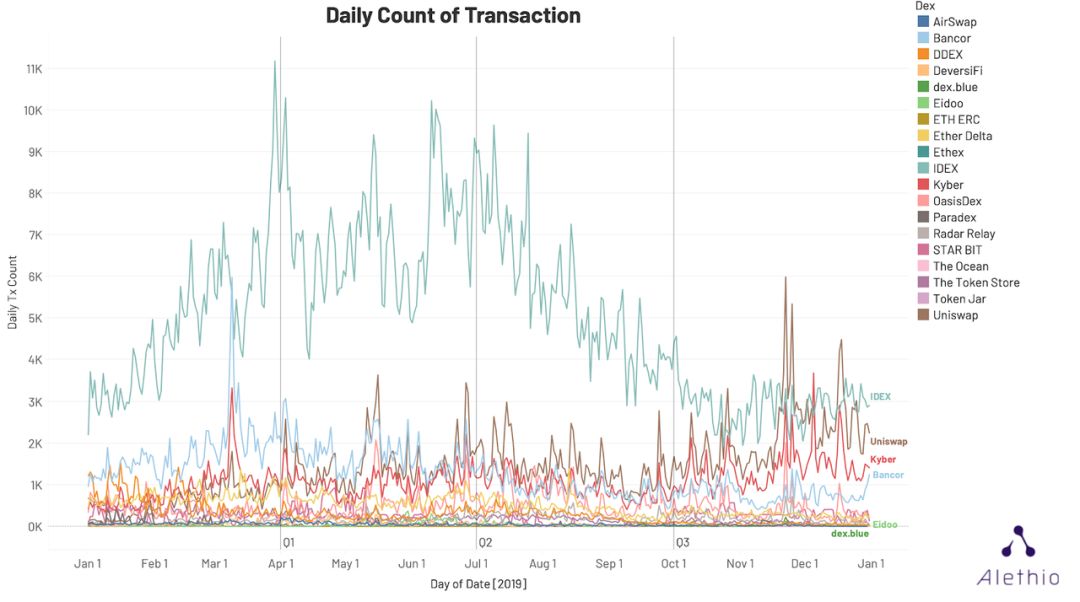
-Figure 1. Statistics of daily transactions of different exchanges-
In the chart below, we will use the same legend as Figure 1 (indicating that the colors of different exchanges will remain the same).
Monthly trading volume statistics of each DEX (measured in ETH)
Most decentralized exchanges do not provide fiat currency entry, so traders on DEX either buy or sell tokens or buy ETH. On some exchanges, a token that encapsulates ETH is needed to trade a certain amount of ETH (such as WETH on 0x, ETHW on DeversiFi, and ETH Token on Bancor), and their value is exactly the same as ETH the same. (Translator's Note: This is generally a technical reason: ETH itself is not a token that conforms to the ERC-20 standard, and the use of the ERC-20 standard facilitates the exchange between tokens, so some contracts will provide for the exchange of ETH with a certain token And other interchangeable functions, and DEX often uses these tokens for technical convenience)
We can divide transactions on DEX into two categories:
- Transactions between tokenX and tokenY
- Transaction between token X and ETH
In estimating the transaction volume of all tokens, we found it difficult to measure the transaction volume in US dollars, because it is difficult to obtain the US dollar prices of all tokens, and these prices are often collected in centralized exchanges. Therefore, we decided to use ETH to calculate the transaction volume, and only consider the transaction volume for ETH (including encapsulated tokens) because the conversion price of the direct token swap transaction (that is, the price of the token to ETH) is neither complete ( Difficult to collect fully) and lagging (only estimates based on recent past transactions). Our data therefore ignores the transaction volume of direct token swaps. However, for most major DEXs, the agreement usually splits the token swap transaction into two transactions: tokenX for ETH and ETH for tokenY, so it counts in our data.
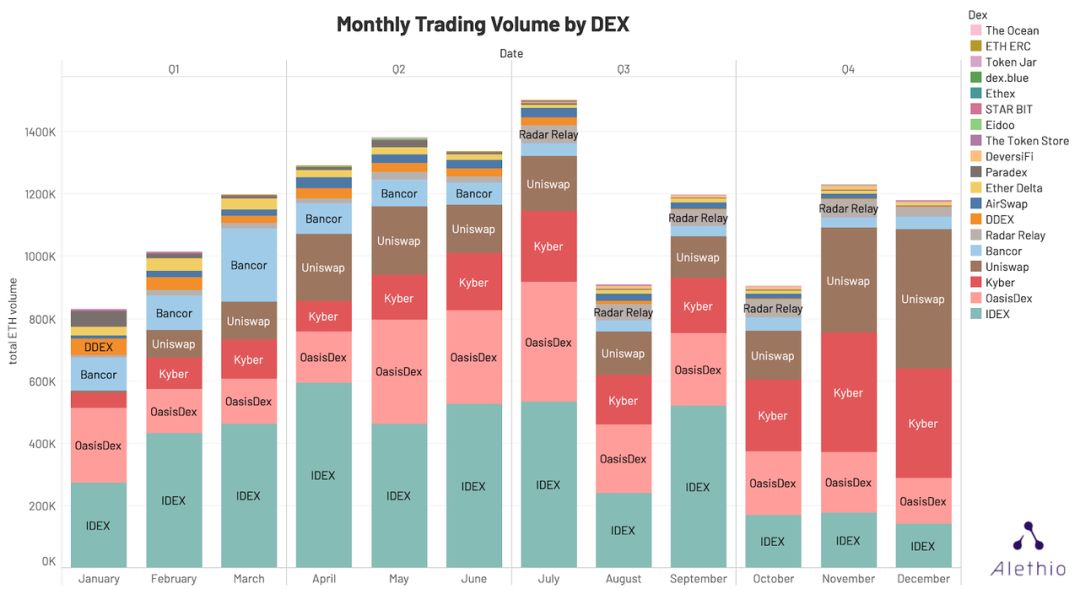
-Figure 2. Monthly trading volume of different exchanges-
Figure 2 shows the ETH transaction volume of each exchange. We see that the ranking of the exchange's total ETH trading volume is quite consistent with the ranking of the transaction number chart (Figure 1). IDEX, the first place in total transaction volume, had an average transaction volume of about 400,000 ETH per month in the first three quarters, but in the fourth quarter, the average monthly transaction volume dropped to 200,000 ETH. OasisDex, Kyber, Bancor, and Uniswap are close behind.
Token performance
Monthly trading volume of each token to ETH
In the past year, we have observed transactions of about 4,300 different tokens on the 20 DEX listed above. The following figure shows the transaction volume of each token against ETH with time as the horizontal axis:

-Figure 3. Monthly transaction volume of ETH to ETH (total of all exchanges)-
With the rise of decentralized finance, Dai stablecoin v1.0 (also known as "Sai" now, before the MakerDAO multi-collateral stablecoin system was launched, users issued stablecoins by collateralizing ETH) became the transaction volume in 2019 The largest token. Other stablecoins including TrueUSD and USDC also maintained high trading volumes throughout the year. The new DAI (labeled "Dai Stablecoin" in the picture) (also known as MakerDAO's multi-collateral DAI) only started to appear in the fourth quarter of 2019, but quickly became the second largest token in transaction volume.
The transaction volume of ChainLink tokens increased rapidly in June and July. This was because the market was very interested in the ChainLink project at that time. What they were doing was oracle service, which is to send real-world data to dApps.
Top 10 Tokens for ETH Trading
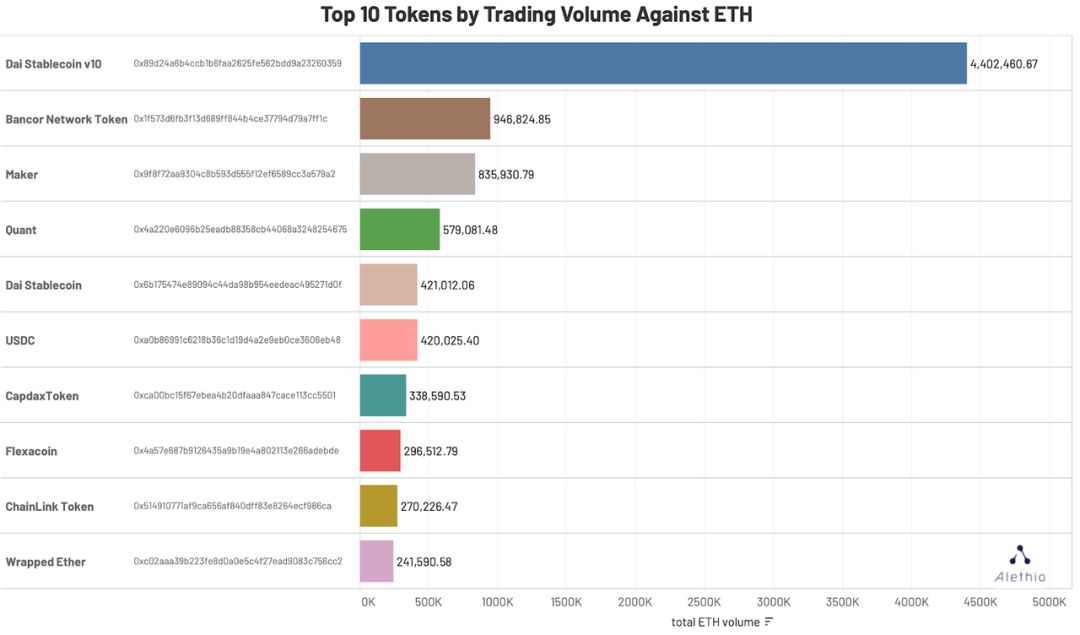
-Figure 4. Top 10 Tokens for ETH trading (total of all exchanges)-
Summing up the transaction volume for the whole year, we find that the transaction volume of SAI (labeled as "Stablecoin v1.0" in Figure 4) is 4.4 million ETH, which is 4.6 times the second-place BNT transaction volume. Figure 4 also shows the projects that have been particularly hot in the past year, including MakerDAO, Quant, Capdex, and Flexacoin.
Further, in the figure below, we use the font size to indicate which exchange platform is providing liquidity for these large transaction tokens. The text is colored according to the DEX it represents, and the size of the font represents the exchange's contribution to that kind of token transaction volume.
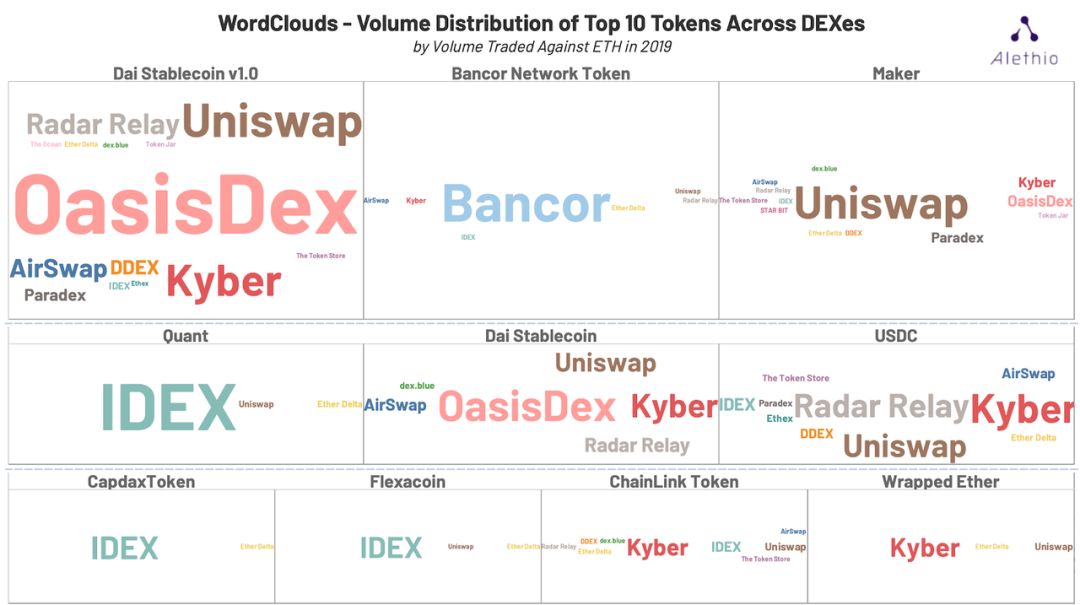
-Figure 5. Trading volume distribution of high-volume tokens on different exchanges-
OasisDex is a trading platform developed by MakerDAO, which contributes most of the SAI transaction volume (about 2.42 million ETH). SAI's trading volume is also distributed on exchanges such as Uniswap, Kyber, RadarRelay, AirSwap, DDEX, and Paradex.
Interestingly, the transaction volume of MakerDAO's native token on Uniswap is larger than that of OasisDex.
BNT token (Bancor Network Token) is basically traded on Bancor. Although it can also be seen on other exchanges, the transaction volume is much smaller. Similarly, the trading volumes of Quant, CapdaxTokan and Flexacoin are basically exclusively owned by IDEX. The main exchange for Chainlink and WETH is Kyber. In contrast, the DAI stablecoin and USDC (the two major stablecoins) have relatively even trading volumes on all major platforms.
Diversity of circulation tokens
Collecting data by exchange, we can see how many tokens are in circulation in these exchanges in 2019. Although EtherDelta is neither in the number of transactions nor in the volume of transactions (according to Figures 1 and 2), it provides the most types of tokens to traders: there are 3190 tokens to trade on.
Note that the "token in circulation" is not the same as the "online token" on the DEX. Because there may be no market buy and sell orders for the tokens supported by the exchange, this number will be less than the number of types of tokens that DEX actually lines.
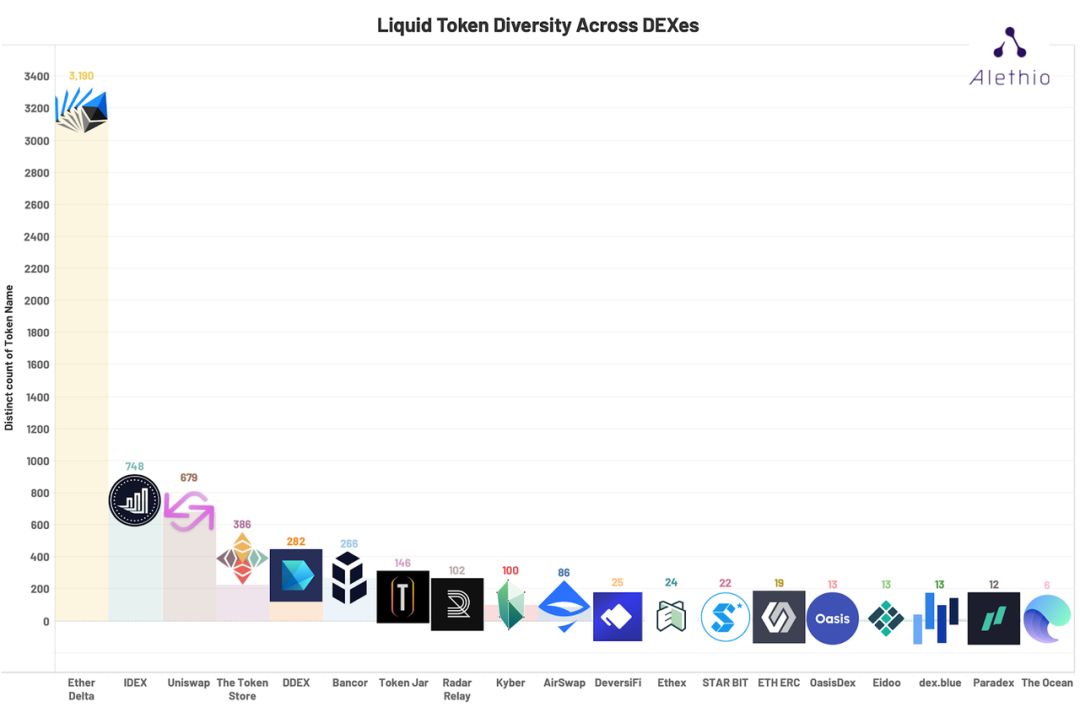
-Figure 6. Diversity of tokens in circulation on various exchanges-
User base
Number of daily active addresses
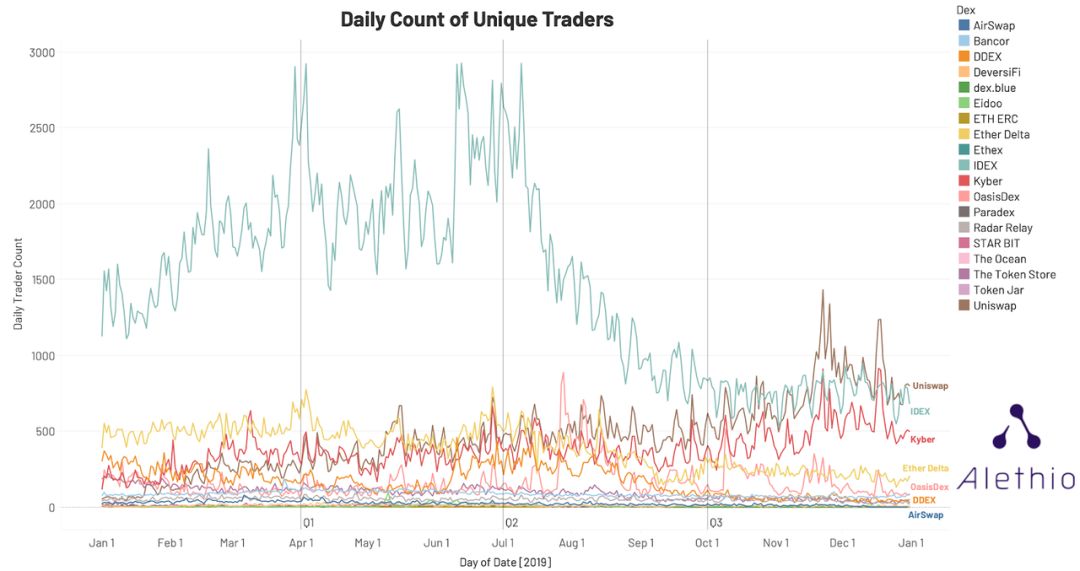
-Figure 7. Number of active transaction addresses (daily)-
On IDEX, the trend of the number of daily active trading addresses is similar to that of the number of transactions and the volume of transactions. Uniswap's active users grew rapidly throughout the year, reaching a peak of approximately 1,300 active addresses in early October. OasisDex's number of active users spiked to about 900 in late July, which may be due to CDP's SAI reward distribution activity.
Another significant correlation appears on Kyber and Uniswap. The number of trading addresses of these two exchanges has been close for a long time, which may suggest that the users of these two platforms are the same group. The network diagram below also confirms this assumption.
Network Diagram: Exploring DEX's User Overlap
By identifying the addresses of the DEX being used (they may be pending or order takers), we can explore the user base of the DEX, including the degree of user overlap between different DEXs.
dex.blue is special. Trade execution does not record trader information, so we cannot collect user data. When understanding this network diagram, it is important to point out that the number of addresses cannot be directly equal to the number of users. A person may use multiple addresses, so the actual user size can be considered smaller than the number of addresses shown in the figure. However, it still tells us the user relationship between these protocols.
Similarly, for some protocols, the scale shown in the figure below will also be smaller than the actual user scale. For example, Bancor is like this. In the Bancor protocol, the recorded transaction address is "forwarder" or "translator ( converter), transactions are handled by them.
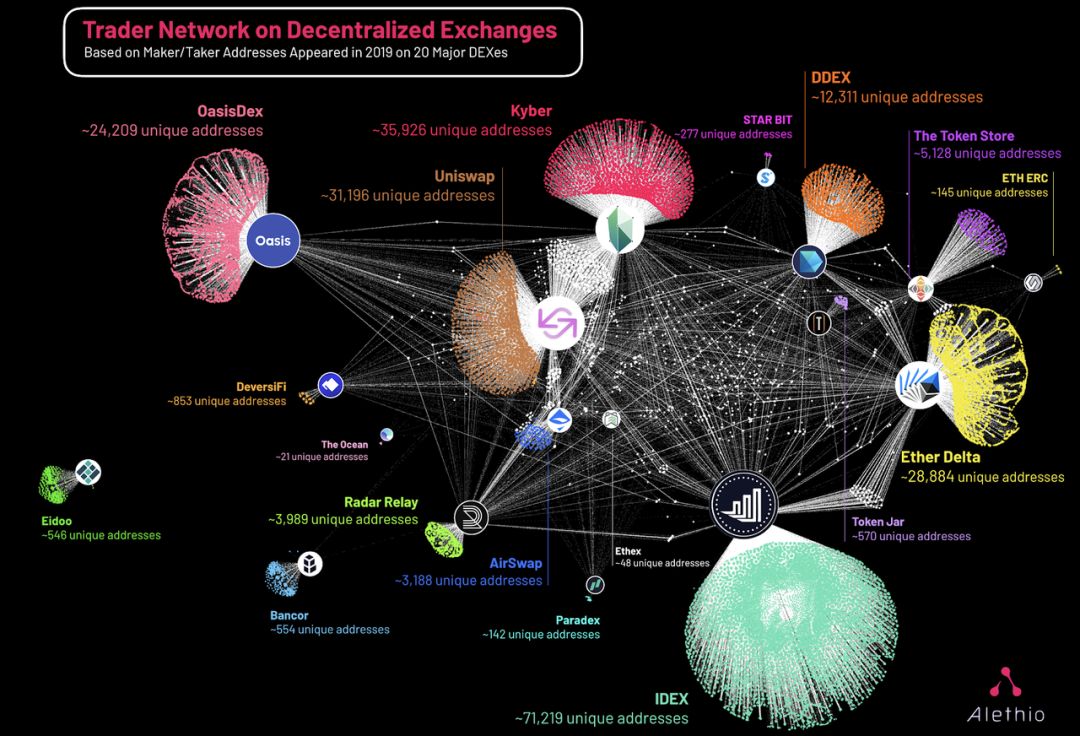
-Figure 8. 2019, the user relationship network of each DEX-
In this picture, colored dots represent "exclusive traders", which are addresses that only buy and sell on a certain trading platform. White dots represent "overlapping traders", which are addresses that use multiple platforms. The number of addresses for each exchange is marked next to it. Note that this number does not represent the number of exclusive traders, but includes the number of exclusive traders and overlapping traders.
In addition, Uniswap and Kyber have the most overlapping traders, which proves our assumptions based on the correlation of the number of active addresses of the two exchanges in time series.
IDEX has the largest group of exclusive traders, followed by OasisDex and EtherDelta.
From the picture, it seems that Bancor and Eidoo are isolated from other exchanges because of the converter / translator mechanism we mentioned above.
Disclaimer: Alethio treats all items mentioned above equally. The number of agreements discussed above is very small, and we will continue to enrich our observation list to obtain more comprehensive results. Alethio has a strong confidence in its neutrality. We only provide facts and draw the best conclusions based on objective and / or verified information. The text is absolutely not intended to provide any guidance or advice for malicious activities or transactions.
(Finish)
We will continue to update Blocking; if you have any questions or suggestions, please contact us!
Was this article helpful?
93 out of 132 found this helpful
Related articles
- DeFi's Dilemma and Change
- New acquisition + new business, founding member of Libra is accelerating expansion
- More than 70% of the 58 blockchain companies are happy to report that 13 of them are expected to double their net profit
- Observation | To what extent has the blockchain traced its origins?
- 2019 Blockchain Industry Annual Report: Technology Giants and Governments of Big Powers Enter, Blockchain Technology Will Transform the World
- Zhu Jiaming: Blockchain will be the basic structure to rebuild human trust
- Global Fintech Financing Report 2019: Financing Amount Exceeds 261.9 Billion, Blockchain Financing Leads Amount






